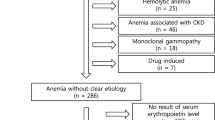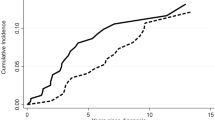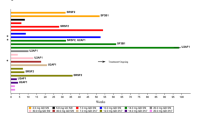Abstract
For cancer patients, anemia can be a debilitating problem that negatively influences their overall quality of life and worsens their prognosis. The condition is caused either by the cancer itself or by cytotoxic treatment. Anemia is the primary indication for transfusion of red blood cells, but the development of recombinant human erythropoietins (epoetins) provides an alternative to red blood cell transfusions. Treatment with epoetins has been shown to reduce transfusion rates and increase hemoglobin response. There is some evidence that epoetins improve quality of life. It remains unclear, however, whether erythropoietin affects tumor growth and survival, and this area requires further investigation. Data from clinical trials suggest that erythropoietin increases the risk of thromboembolic complications. In the management of anemic patients, physicians should follow closely the dosing recommendations in products' package inserts or the ASCO/American Society of Hematology guidelines. Treatment of patients beyond the correction of anemia, however, has to be regarded as experimental and is potentially harmful, so should only be conducted in clinical trials.
Key Points
-
The pathophysiology of tumor anemia is multifactorial, and treatment with recombinant human erythropoietins has been shown to reduce transfusion rates and increase hemoglobin (Hb) response
-
For many cancers anemia is known to be a factor associated with a worse prognosis
-
In cancer patients, cytostatic therapy and radiation can aggravate anemia, and platinum-based chemotherapy regimens might diminish endogenous erythropoietin
-
Dose-intensified treatment regimens or shortened treatment intervals are associated with a higher degree of anemia
-
Systematic review analysis showed that patients receiving erythropoietin are three to four times more likely to achieve Hb response (Hb increase of 2 g/dl) than those not treated with this agent
-
Thromboembolic complications can be increased in patients receiving erythropoietin, and is not recommended in patients with Hb levels >12 g/dl
This is a preview of subscription content, access via your institution
Access options
Subscribe to this journal
Receive 12 print issues and online access
$209.00 per year
only $17.42 per issue
Buy this article
- Purchase on Springer Link
- Instant access to full article PDF
Prices may be subject to local taxes which are calculated during checkout


Similar content being viewed by others
References
Ludwig H et al. (2004) The European Cancer Anaemia Survey (ECAS): a large, multinational, prospective survey defining the prevalence, incidence, and treatment of anaemia in cancer patients. Eur J Cancer 40: 2293–2306
Knight K et al. (2004) Prevalence and outcomes of anemia in cancer: a systematic review of the literature. Am J Med 116 (Suppl 7A): S11–S26
Groopman JE and Itri LM (1999) Chemotherapy-induced anemia in adults: incidence and treatment. J Natl Cancer Inst 91: 1616–1634
Spivak JL (2005) The anaemia of cancer: death by a thousand cuts. Nat Rev Cancer 5: 543–555
Miller CB et al. (1990) Decreased erythropoietin response in patients with the anemia of cancer. N Engl J Med 322: 1689–1692
Wood PA and Hrushesky WJ (1995) Cisplatin-associated anemia: an erythropoietin deficiency syndrome. J Clin Invest 95: 1650–1659
Ludwig H and Strasser K (2001) Symptomatology of anemia. Semin Oncol 28: 7–14
Cella D (1997) The Functional Assessment of Cancer Therapy—Anemia (FACT-An) Scale: a new tool for the assessment of outcomes in cancer anemia and fatigue. Semin Hematol 34: 13–19
Holzner B et al. (2002) The impact of hemoglobin levels on fatigue and quality of life in cancer patients. Ann Oncol 13: 965–973
Lind M et al. (2002) The level of haemoglobin in anaemic cancer patients correlates positively with quality of life. Br J Cancer 86: 1243–1249
Vogelzang NJ et al. (1997) Patient, caregiver, and oncologist perceptions of cancer-related fatigue: results of a tripart assessment survey. The Fatigue Coalition. Semin Hematol 34: 4–12
Ahlberg K et al. (2003) Assessment and management of cancer-related fatigue in adults. Lancet 362: 640–650
Mock V (2004) Evidence-based treatment for cancer-related fatigue. J Natl Cancer Inst Monogr 112–118
Caro JJ et al. (2001) Anemia as an independent prognostic factor for survival in patients with cancer: a systemic, quantitative review. Cancer 91: 2214–2221
Vaupel P and Mayer A (2005) Hypoxia and anemia: effects on tumor biology and treatment resistance. Transfus Clin Biol 12: 5–10
Schrijvers D et al. (1999) Role of red blood cells in pharmacokinetics of chemotherapeutic agents. Anticancer Drugs 10: 147–153
Hockel M et al. (1993) Intratumoral pO2 predicts survival in advanced cancer of the uterine cervix. Radiothe Oncol 26: 45–50
Kelleher DK et al. (1996) Blood flow, oxygenation, and bioenergetic status of tumors after erythropoietin treatment in normal and anemic rats. Cancer Res 56: 4728–4734
Thews O et al. (1998) Enhanced radiosensitivity in experimental tumours following erythropoietin treatment of chemotherapy-induced anaemia. Br J Cancer 78: 752–756
Silver DF and Piver MS (1999) Effects of recombinant human erythropoietin on the antitumor effect of cisplatin in SCID mice bearing human ovarian cancer: a possible oxygen effect. Gynecol Oncol 73: 280–284
Thews O et al. (2001) Erythropoietin restores the anemia-induced reduction in cyclophosphamide cytotoxicity in rat tumors. Cancer Res 61: 1358–1361
Stuben G et al. (2003) Erythropoietin restores the anemia-induced reduction in radiosensitivity of experimental human tumors in nude mice. Int J Radiat Oncol Biol Phys 55: 1358–1362
Goodnough LT (2005) Risks of blood transfusion. Anesthesiol Clin North America 23: 241–252
Engert A (2000) Recombinant human erythropoietin as an alternative to blood transfusion in cancer-related anaemia. Dis Manage Health Outcomes 8: 259–272
Toy P et al. (2005) Transfusion-related acute lung injury: definition and review. Crit Care Med 33: 721–726
Goodnough LT et al. (1999) Transfusion medicine: first of two parts—blood transfusion. N Engl J Med 340: 438–447
Blajchman MA and Hebert PC (2001) Red blood cell transfusion strategies. Transfus Clin Biol 8: 207–210
Hill SR et al. (2006) Transfusion thresholds and other strategies for guiding allogeneic red blood cell transfusion. The Cochrane Database of Systematic Reviews, Issue 1, Art. No CD002042
Hebert PC et al. (1999) A multicenter, randomized, controlled clinical trial of transfusion requirements in critical care. Transfusion Requirements in Critical Care Investigators, Canadian Critical Care Trials Group. N Engl J Med 340: 409–417
Murphy MF et al. (2001) Guidelines for the clinical use of red cell transfusions. Br J Haematol 113: 24–31
Simon TL et al. (1998) Practice parameter for the use of red blood cell transfusions: developed by the Red Blood Cell Administration Practice Guideline Development Task Force of the College of American Pathologists. Arch Pathol Lab Med 122: 130–138
Lai PH et al. (1986) Structural characterization of human erythropoietin. J Biol Chem 261: 3116–3121
Koury ST et al. (1988) Localization of erythropoietin synthesizing cells in murine kidneys by in situ hybridization. Blood 71: 524–527
Koury ST et al. (1991) Localization of cells producing erythropoietin in murine liver by in situ hybridization. Blood 77: 2497–2503
D'Andrea AD et al. (1989) Expression cloning of the murine erythropoietin receptor. Cell 57: 277–285
Koury MJ and Bondurant MC (1990) Erythropoietin retards DNA breakdown and prevents programmed death in erythroid progenitor cells. Science 248: 378–381
Goldwasser E et al. (1974) On the mechanism of erythropoietin-induced differentiation: the role of sialic acid in erythropoietin action. J Biol Chem 249: 4202–4206
Procrit® epoetin alfa full prescribing information [http://www.orthobiotech.com/common/prescribing_information/ PROCRIT/PDF/ProcritBooklet.pdf]
Roche UK package leafeat [http://www.rocheuk.com/ProductDB/Documents/rx/pil/ NeoRecormon_PFS_PIL.pdf]
Aranesp® (darbepoetin alfa) prescribing information [http://www.aranesp.com/pdf/aranesp_PI.pdf]
Egrie JC et al. (2003) Darbepoetin alfa has a longer circulating half-life and greater in vivo potency than recombinant human erythropoietin. Exp Hematol 31: 290–299
Morreale A et al. (2004) Clinical and economic comparison of epoetin alfa and darbepoetin alfa. Curr Med Res Opin 20: 381–395
Halstenson CE et al. (1991) Comparative pharmacokinetics and pharmacodynamics of epoetin alfa and epoetin beta. Clin Pharmacol Ther 50: 702–712
Storring PL et al. (1998) Epoetin alfa and beta differ in their erythropoietin isoform compositions and biological properties. Br J Haematol 100: 79–89
Glaspy J et al. (2005) Final results of a phase 3, randomized, open-label study of darbepoetin alfa 200 mcg every 2 weeks (Q2W) versus epoetin alfa 40,000 U weekly (QW) in patients with chemotherapy-induced anemia (CIA) [abstract #8125]. J Clin Oncol 23
Cazzola M et al. (2003) Once-weekly epoetin beta is highly effective in treating anaemic patients with lymphoproliferative malignancy and defective endogenous erythropoietin production. Br J Haematol 122: 386–393
Rodgers GM et al. (online 2005) Cancer- and treatment-related anemia: NCCN Clinical Practice Guidelines in Oncology 2-2005[2.2005] [www.nccn.org/professionals/physician_gls/PDF/anemia.pdf, NCCN National Comprehensive Cancer Network] (accessed 27 January 2006)
Waltzman RJ et al. (2005) Final haematologic results: epoetin alfa (EPO) 40,000 U QW vs darbepoetin alfa (DARB) 200 µg Q2W in anemic cancer patients (pts) receiving chemotherapy (CT) [abstract #8030]. Proc Am Soc Clin Oncol 23: a736s
Weingart O et al. (2005) Is the evidence cited in evidence-based guidelines constructive and sufficient for the development of adapted guidelines? 3rd Guideline International Network Conference, December 2005. Lyon: Guidelines International Network.
Rizzo JD et al. (2002) Use of epoetin in patients with cancer: evidence-based clinical practice guidelines of the American Society of Clinical Oncology and the American Society of Hematology. J Clin Oncol 20: 4083–4107
Bokemeyer C et al. (2004) EORTC guidelines for the use of erythropoietic proteins in anaemic patients with cancer. Eur J Cancer 40: 2201–2216
Quirt I et al. and the Systemic Treatment Disease Site Group. (2005) The role of erythropoietin in the management of cancer patients with non-hematologic malignancies receiving chemotherapy [http://www.guideline.gov/summary/summary.aspx?ss=14&doc_id=7217&string=] (accessed 27 January 2006)
Seidenfeld J et al. (2001) Epoetin treatment of anemia associated with cancer therapy: a systematic review and meta-analysis of controlled clinical trials. J Natl Cancer Inst 93: 1204–1214
Bottomley A et al. (2002) Human recombinant erythropoietin and quality of life: a wonder drug or something to wonder about? Lancet Oncol 3: 145–153
Bohlius J et al. Erythropoietin for patients with malignant disease. The Cochrane Database of Systematic Reviews, Issue 3, Art. No CD003407
Littlewood TJ et al. (2001) Effects of epoetin alfa on hematologic parameters and quality of life in cancer patients receiving nonplatinum chemotherapy: results of a randomized, double-blind, placebo-controlled trial. J Clin Oncol 19: 2865–2874
Bohlius J et al. (2005) Recombinant human erythropoietin and overall survival in cancer patients: results of a comprehensive meta-analysis. J Natl Cancer Inst 97: 489–498
Clark O et al. (2002) Erythropoietin, uncertainty principle and cancer related anaemia. BMC Cancer 2: 23
Vansteenkiste J et al. (2002) Double-blind, placebo-controlled, randomized phase III trial of darbepoetin alfa in lung cancer patients receiving chemotherapy. J Natl Cancer Inst 94: 1211–1220
Hedenus M et al. (2003) Efficacy and safety of darbepoetin alfa in anaemic patients with lymphoproliferative malignancies: a randomized, double-blind, placebo-controlled study. Br J Haematol 122: 394–403
Ludwig H et al. (1994) Prediction of response to erythropoietin treatment in chronic anemia of cancer. Blood 84: 1056–1063
Witzig TE et al. (2005) Phase III, randomized, double-blind study of epoetin alfa compared with placebo in anemic patients receiving chemotherapy. J Clin Oncol 23: 2606–2617
Glaspy J et al. (1997) Impact of therapy with epoetin alfa on clinical outcomes in patients with nonmyeloid malignancies during cancer chemotherapy in community oncology practice. J Clin Oncol 15: 1218–1234
Demetri GD et al. (1998) Quality-of-life benefit in chemotherapy patients treated with epoetin alfa is independent of disease response or tumor type: results from a prospective community oncology study. J Clin Oncol 16: 3412–3425
Gabrilove JL et al. (2001) Clinical evaluation of once-weekly dosing of epoetin alfa in chemotherapy patients: improvements in hemoglobin and quality of life are similar to three-times-weekly dosing. J Clin Oncol 19: 2875–2882
Shasha D et al. (2003) Once-weekly dosing of epoetin-alpha increases hemoglobin and improves quality of life in anemic cancer patients receiving radiation therapy either concomitantly or sequentially with chemotherapy. Cancer 98: 1072–1079
Osterborg A et al. (2002) Randomized, double-blind, placebo-controlled trial of recombinant human erythropoietin, epoetin beta, in hematologic malignancies. J Clin Oncol 20: 2486–2494
Boogaerts M et al. (2003) Impact of epoetin beta on quality of life in patients with malignant disease. Br J Cancer 88: 988–995
Aaronson NK (1991) Methodologic issues in assessing the quality of life in cancer patients. Cancer 67: 844–850
Henke M et al. (2003) Erythropoietin to treat head and neck cancer patients with anaemia undergoing radiotherapy: randomised, double-blind, placebo-controlled trial. Lancet 362: 1255–1260
Leyland-Jones B (2003) Breast cancer trial with erythropoietin terminated unexpectedly. Lancet Oncol 4: 459–460
Leyland-Jones B et al. (2005) Maintaining normal hemoglobin levels with epoetin alfa in mainly nonanemic patients with metastatic breast cancer receiving first-line chemotherapy: a survival study. J Clin Oncol 23: 5960–5972
Luksenburg H et al. (2004) FDA Oncologic Drugs Advisory Committee briefing document: Safety concerns associated with Aranesp (darbepoetin alfa) Amgen, Inc. and Procrit (epoetin alfa) Ortho Biotech, L.P., for the treatment of anemia associated with cancer chemotherapy, FDA. [http://www.fda.gov/ohrms/dockets/ac/04/briefing/4037b2.htm] (accessed 22 June 2005)
Acs G et al. (2001) Erythropoietin and erythropoietin receptor expression in human cancer. Cancer Res 61: 3561–3565
Arcasoy MO et al. (2002) Functional significance of erythropoietin receptor expression in breast cancer. Lab Invest 82: 911–918
Jelkmann W and Wagner K (2004) Beneficial and ominous aspects of the pleiotropic action of erythropoietin. Ann Hematol 83: 673–686
Arcasoy MO et al. (2005) Erythropoietin and erythropoietin receptor expression in head and neck cancer: relationship to tumor hypoxia. Clin Cancer Res 11: 20–27
Rosen FR et al. (2003) Multicenter randomized phase II study of paclitaxel (1-hour infusion), fluorouracil, hydroxyurea, and concomitant twice daily radiation with or without erythropoietin for advanced head and neck cancer. Clin Cancer Res 9: 1689–1697
Machtay M et al. (2004) Definitive radiotherapy +/− erythropoietin for squamous cell carcinoma of the head and neck: preliminary report of RTOG 99-03. Int J Radiat Oncol Biol Phys 60 (Suppl 1): S132
Antonadou D et al. (2001) Erythropoietin enhances radiation treatment efficacy in patients with pelvic malignancies: final results of a randomized phase III study. Eur J Cancer 37 (Suppl 6): S144
Blohmer JU et al. (2004) Results with sequential adjuvant chemo-radiotherapy [abstract #447PD]. Ann Oncol 15 (Suppl 3)
Besarab A et al. (1998) The effects of normal as compared with low hematocrit values in patients with cardiac disease who are receiving hemodialysis and epoetin. N Engl J Med 339: 584–590
Wun T et al. (2003) Increased incidence of symptomatic venous thrombosis in patients with cervical carcinoma treated with concurrent chemotherapy, radiation, and erythropoietin. Cancer 98: 1514–1520
Valles J et al. (2002) Platelet-erythrocyte interactions enhance αIIbβ3 integrin receptor activation and P-selectin expression during platelet recruitment: down-regulation by aspirin ex vivo. Blood 99: 3978–3984
Stohlawetz PJ et al. (2000) Effects of erythropoietin on platelet reactivity and thrombopoiesis in humans. Blood 95: 2983–2989
Nowrousian MR et al. (1996) rh-Erythropoietin in Cancer Supportive Treatment, 13–34 New York: Marcel Dekker
Abels R (1993) Erythropoietin for anemia in cancer patients. Eur J Cancer 29A (Suppl 2): S2–S8
Case DC et al. (1993) Recombinant human erythropoietin therapy for anemic cancer patients on combination chemotherapy. J Natl Cancer Inst 85: 801–806
Henry DH et al. (1995) Recombinant human erythropoietin therapy for anemic cancer patients receiving cisplatin chemotherapy. Cancer J Sci Am 1: 252–260
Oberhoff C et al. (1998) Recombinant human erythropoietin in the treatment of chemotherapy-induced anemia and prevention of transfusion requirement associated with solid tumors: a randomized, controlled study. Ann Oncol 9: 255–260
Chang J et al. (2005) Once weekly epoetin alfa maintains hemoglobin, improves quality of life, and reduces transfusion in breast cancer patients receiving chemotherapy. J Clin Oncol 23: 2597–2605
Savonije JH et al. (2005) Effects of early intervention with epoetin alfa on transfusion requirement, hemoglobin level and survival during platinum-based chemotherapy: results of a multicenter randomised controlled trial. Eur J Cancer 41: 1560–1569
Author information
Authors and Affiliations
Corresponding author
Ethics declarations
Competing interests
The authors declare no competing financial interests.
Rights and permissions
About this article
Cite this article
Bohlius, J., Weingart, O., Trelle, S. et al. Cancer-related anemia and recombinant human erythropoietin—an updated overview. Nat Rev Clin Oncol 3, 152–164 (2006). https://doi.org/10.1038/ncponc0451
Received:
Accepted:
Issue Date:
DOI: https://doi.org/10.1038/ncponc0451
This article is cited by
-
A comprehensive analysis of the association between anemia and systemic inflammation in older patients with cancer
Supportive Care in Cancer (2024)
-
Outcomes of kidney injury including dialysis and kidney transplantation in pediatric oncology and hematopoietic cell transplant patients
Pediatric Nephrology (2021)
-
Efficacy and safety of a biogeneric recombinant human erythropoietin in the management of chemotherapy-induced anemia: a randomized double-blind active-comparator trial
Comparative Clinical Pathology (2016)
-
Erythropoietin treatment in chemotherapy-induced anemia in previously untreated advanced esophagogastric cancer patients
International Journal of Clinical Oncology (2014)
-
Vaccinia Virus-mediated Expression of Human Erythropoietin in Tumors Enhances Virotherapy and Alleviates Cancer-related Anemia in Mice
Molecular Therapy (2013)



